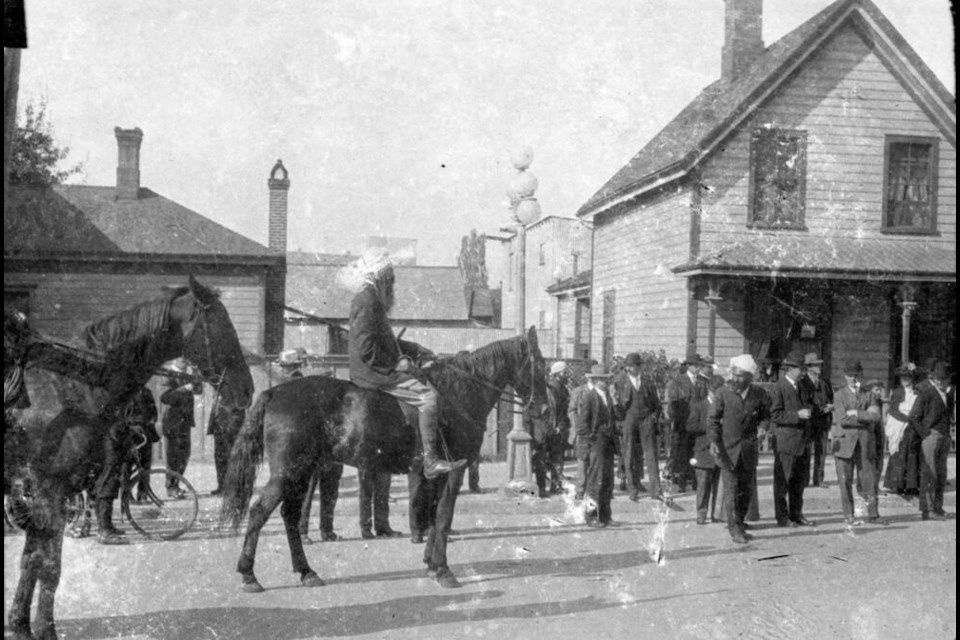Jindi Singh was combing through the City of Victoria archives when he stumbled upon a rare photo of a renowned Sikh advocate who helped to establish Victoria’s first purpose-built gurdwara in 1912.
Unable to believe his eyes, he texted the photo of Sant Teja Singh on horseback to fellow Sikh researcher Paneet Singh: Could this be him?
There are just a handful of surviving photos taken in B.C. of Teja Singh, a Sikh intellectual who held great influence in the early Canadian Sikh communities.
“I got really excited right away,” said Paneet Singh.
The photo, which was only recently made digitally available by City of Victoria archives, was taken by Daily Colonist reporter and photographer Richard Pocock and had not been published before. It came with another photo taken around the same time at the intersection of Yates and Quadra streets.
Both were simply labelled in the archive as a “South Asian Parade” that occurred some time in the 1910s.
The two community historians, who have kept the photo a secret since its discovery in August, are publicizing their finding today on the 112th anniversary of the event.
On Oct. 6, 1912, Teja Singh led a historic procession celebrating the dedication of the Khalsa Diwan temple in Victoria, the third gurdwara built in North America and the first on the continent built with brick.
Almost 1,000 Sikhs attended the march to 1210 Topaz Ave. from Government and Herald streets, as reported by the Daily Colonist, precursor to the Times Colonist.
Teja Singh’s identity in the photo was confirmed through published descriptions of the procession.
The procession, which drew about one-fifth of all Sikhs in Canada at the time, was held in a period when Victoria was violently racist, Paneet Singh said.
Just four years previously, in 1908, Teja Singh, a Cambridge- and Columbia-educated humanitarian and intellectual, had to help stop a secret Canadian government plan that would have led to the mass deportation all South Asians in Canada to British Honduras, now modern-day Belize.
In comments published by the Victoria Daily Times a month before Teja Singh’s march through Victoria, then-mayor John Beckwith characterized South Asians — whom he referred to as Hindus — as “unsuited to the country” as well as “immoral and quarrelsome.”
At the same time, Beckwith worried publicly about South Asians becoming too successful and demanding full rights of citizenship.
But on the day of the march, the counter protest feared by police did not materialize and the procession took place without incident, according to the Daily Colonist.
Paneet Singh said accounts from that day in the Sikh community suggested that by end of the march, more white Canadians were in the procession than Sikhs because everyone wanted to take a look.
Satwinder Bains, associate professor and director of South Asian studies at the University of Fraser Valley, said the rare photo represents the early Sikh history in Canada that has been lost to time.
“We know they’re out there, but they’re so rare and so little and difficult to find that when something is found … it just reinforces that amazing, forward looking [Sikh] people regardless of the racism around them.”
Early Sikh settlers in Canada were largely male service-members and former service-members hailing from far-flung outposts of the British Empire such as Shanghai, Hong Kong, Singapore and Malaysia, she said.
Many of them sought the right to vote and for immigration rights from India — both of which were denied to Sikhs at the time.
Support from someone like Teja Singh — western-educated and highly learned in Sikhism — was like a legend come true for many, she said.
One Province newspaper report from that time said Teja Singh was treated like a “veritable demigod” by his people.
Teja Singh, who was in B.C. from 1908 to about 1912 after his studies at Columbia, helped to establish a number of early influential Sikh Canadian organizations such as the Khalsa Diwan Society and the Guru Nanak Mining & Trust company.
Bains said early Sikh accomplishments in Canada are not as well known as they should be due to a lack of research.
Paneet Singh, who co-hosts the The Nameless Collective, a South Asian history podcast, has gathered more information about the Victoria Sikh community’s Oct. 6, 1912 celebration, including Tejah Singh’s own recollections of the event — which has been published online.
Last year, in recognition of Teja Singh’s dedication to fighting discrimination and challenging inequality, the province of British Columbia declared July 1, 2023 as Sant Teja Singh Day.
>>> To comment on this article, write a letter to the editor: [email protected]




